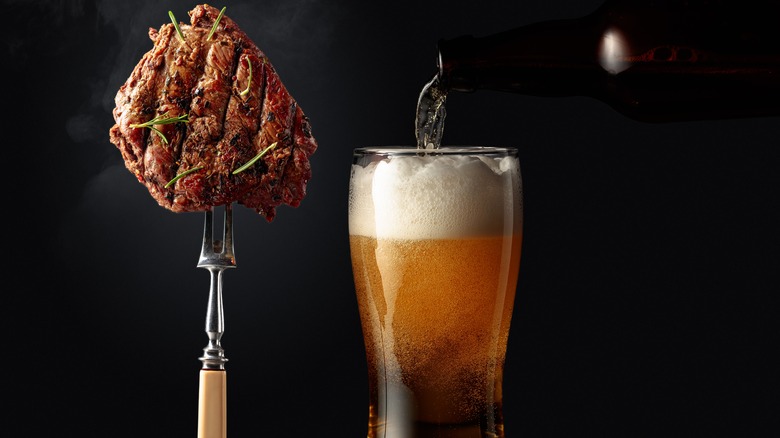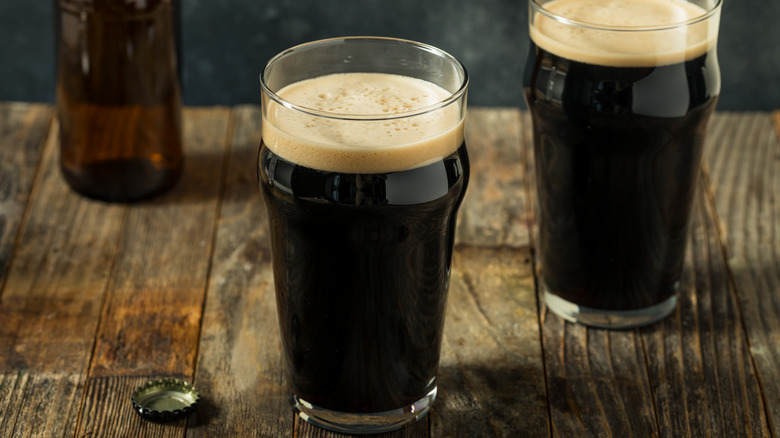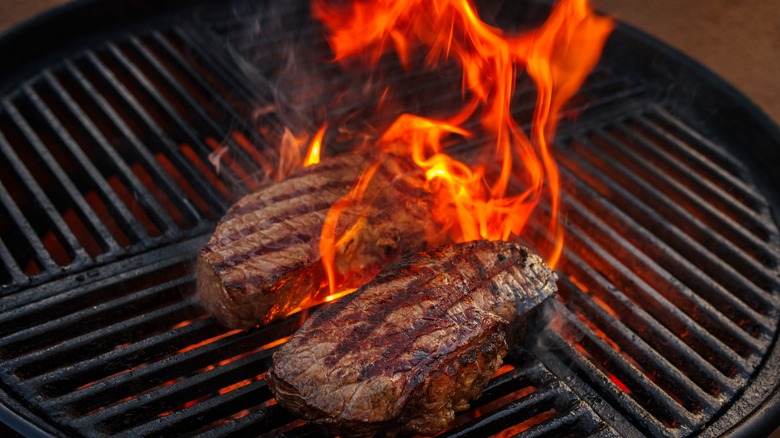Your Beer Is Brown For The Same Reason Your Steak Is Brown
Let's say you're making yourself a big breakfast of sausage, toast, and coffee; later, a large dinner with steak or chicken as the main course, a side of grilled veggies, and a glass of dark beer on the side. It might be hard to picture in text, but if you could see all these foods laid out in front of you, then you would notice that everything is mostly the same brownish color. That's not a coincidence, and if you're trying to improve at cooking, there's some food science behind this which can help you.
The phenomenon at play here is called the Maillard reaction. It's a chemical reaction involving the compounds in your food which changes up their properties. These reactions can be seen every time you eat steak with beer, which turn brown the same way. The short version is that the food's proteins and sugars are altered when exposed to enough heat, and the end result is a brown pigment and a "roasted" smell and taste which we associate with cooked food. Cooking food is most important because it kills germs, to be sure, but the Maillard reaction is why cooked food tastes better.
The science of browning
Let's go into even more detail: Proteins (which are built from amino acids) and sugars are common in the foods we eat. When exposed to a temperature of 285 degrees Fahrenheit or higher and low moisture, the sugars and amino acids react together and rearrange themselves into new, complex compounds. Besides changing color, they form new flavors in the food ranging from nutty to cooked or even burnt.
There are many different, small chemical reactions occurring during the Maillard reaction. The process is more commonly called browning, which you've likely heard more often. It can transform reddish raw beef into the darker-colored food we recognize as safe to eat — we've likely evolved to think browned food smells and tastes superior to raw food. The Maillard reaction also marks a major difference between dark beer and light beer. When making darker beers such as stouts, brewers will roast the malt (the grain used in beer making) at higher temperatures, resulting in darker-colored wort (the extracted, sugary liquid which gets boiled and fermented into beer). A heavily roasted wort gives the beer a deep brown color and a much bolder flavor than light ales.
How to use the Maillard reaction
Humankind has been using the Maillard reaction for as long as we've been cooking food (about 780,000 years ago according to current estimates) although it wasn't until approximately 1910 that the French scientist Louis-Camille Maillard identified it. Now that you know about it, you can tweak your Maillard methods to your advantage while cooking. For example, adding extra sugars or proteins to your food before cooking can actually increase the amount of Maillard reactions, giving your food more flavor. This could mean adding protein-heavy soy sauce (which is also dark brown because of the Maillard reaction — one ingredient is roasted wheat berries) to your food.
Adding ingredients with high pH levels is another way to go about it, including highly basic (meaning the opposite of acidic) substances such as baking soda that can speed up Maillard reactions, which essentially helps tenderize your meat. It also works to keep your meat dry, since moisture interferes with the chemical reactions. Finally, there's a simpler answer as well: You can brown your meat by cooking it for longer at higher temperatures, as long as you cook your cut of steak the proper way.


